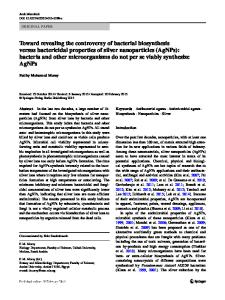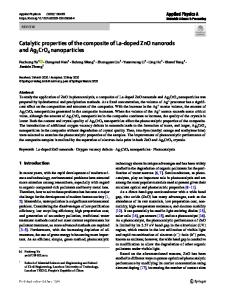Study of Bactericidal Properties of Mg-Doped ZnO Nanoparticles
- PDF / 416,686 Bytes
- 6 Pages / 432 x 648 pts Page_size
- 85 Downloads / 316 Views
Study of Bactericidal Properties of Mg-Doped ZnO Nanoparticles Perez-Altamar, Melina1; Marrero, Hilary2.; Martínez Julca, Milton3; Perales Perez, Oscar1,4 1 Department of food Science and technology, 2Department of Industrial Biotechnology, 3 Department of Physic; 4Department of Engineering Science and Materials University of Puerto Rico-Mayagüez, Mayagüez PR 00681-9000 Author’s e-mail: [email protected]; [email protected]
ABSTRACT The present work focuses on the polyol-mediated synthesis of pure and Mg-doped ZnO nanoparticles. The synthesized samples were characterized via X-ray diffraction, Fourier transformed infrared spectroscopy, ultraviolet visible spectroscopy and photoluminescence techniques. The Standard Plate Count was used to assess the bactericidal properties of the nanoparticles against E. coli at 1000 ppm and 1500 ppm of concentration. The capacity of the Zn-Mg oxides to generate singlet oxygen (SO) species was also evaluated. X-ray diffraction information evidenced the formation of ZnO-wurtzite; no diffraction peaks corresponding to isolated Mg-phases were detected. The average crystallite size of the Zn-Mg oxide nanocrystals was estimated in the 6nm - 7nm range. Infrared spectroscopy measurements confirmed the formation of the oxide with a Metal-Oxygen band centered on 536 cm-1; other bands associated to the functional groups of polyol by product were also observed. The exciton peak of UV spectrum suggests similarity in the particle size with the dopant addition. The effect of particle composition (i.e. doping level) on the corresponding generation of SO and bactericidal capacity is presented and discussed. INTRODUCTION Materials at nanoscale are moving scientists and technologists into a new research path due to their number of current and potential applications. The development of size-dependent functionality materials with applications in biomedicine, drug delivery, solar cells, etc., are giving a rising impetus to the nanotechnology field. Metal oxides have received interest over the last years due to their potential applications and between them, zinc oxide exhibits many advantages [1]. Zinc oxide has been studied as an antimicrobial agent for the last few years because is an environmentally friendly compound, stable, non-toxic and is considered a safe compound by the United States Food and Drug Administration (21 CFR 182.8991) with a variety of biological, electronic and optical applications. Zinc oxide is a semiconductor material with a band gap of 3.37eV with excitonic energy of 60meV and a hexagonal wurtzite type stable structure [2]. Doping nanostructures is an efficient method of control and enhance their properties; ZnO can be doped with elements like Li, Al, Mn and Cr to control their optical and electrical properties [3]. Zn+2 and Mg+2 ionic radius are 0.72Å and 0.65Å respectively, which suggest the capability to form solid solutions of the type Zn1-xMgxO. It has been suggested that Mg doping influenced the bactericidal capacity of ZnO while enhancing UV blocking capacity o
Data Loading...











